Show EOL distros:
Package Summary
A ros package that includes plugins and nodes to convert occupied costmap2d cells to primitive types.
- Maintainer status: developed
- Maintainer: Christoph Rösmann <christoph.roesmann AT tu-dortmund DOT de>
- Author: Christoph Rösmann <christoph.roesmann AT tu-dortmund DOT de>, Franz Albers <franz.albers AT tu-dortmund DOT de>, Otniel Rinaldo <otniel.rinaldo AT tu-dortmund DOT de>
- License: BSD
- Source: git https://github.com/rst-tu-dortmund/costmap_converter.git (branch: master)
Package Summary
A ros package that includes plugins and nodes to convert occupied costmap2d cells to primitive types.
- Maintainer status: developed
- Maintainer: Christoph Rösmann <christoph.roesmann AT tu-dortmund DOT de>
- Author: Christoph Rösmann <christoph.roesmann AT tu-dortmund DOT de>, Franz Albers <franz.albers AT tu-dortmund DOT de>, Otniel Rinaldo <otniel.rinaldo AT tu-dortmund DOT de>
- License: BSD
- Source: git https://github.com/rst-tu-dortmund/costmap_converter.git (branch: master)
Package Summary
A ros package that includes plugins and nodes to convert occupied costmap2d cells to primitive types.
- Maintainer status: developed
- Maintainer: Christoph Rösmann <christoph.roesmann AT tu-dortmund DOT de>
- Author: Christoph Rösmann <christoph.roesmann AT tu-dortmund DOT de>, Franz Albers <franz.albers AT tu-dortmund DOT de>, Otniel Rinaldo <otniel.rinaldo AT tu-dortmund DOT de>
- License: BSD
- Source: git https://github.com/rst-tu-dortmund/costmap_converter.git (branch: master)
Package Summary
A ros package that includes plugins and nodes to convert occupied costmap2d cells to primitive types.
- Maintainer status: developed
- Maintainer: Christoph Rösmann <christoph.roesmann AT tu-dortmund DOT de>
- Author: Christoph Rösmann <christoph.roesmann AT tu-dortmund DOT de>, Franz Albers <franz.albers AT tu-dortmund DOT de>, Otniel Rinaldo <otniel.rinaldo AT tu-dortmund DOT de>
- License: BSD
- Source: git https://github.com/rst-tu-dortmund/costmap_converter.git (branch: master)
Package Summary
A ros package that includes plugins and nodes to convert occupied costmap2d cells to primitive types.
- Maintainer status: developed
- Maintainer: Christoph Rösmann <christoph.roesmann AT tu-dortmund DOT de>
- Author: Christoph Rösmann <christoph.roesmann AT tu-dortmund DOT de>, Franz Albers <franz.albers AT tu-dortmund DOT de>, Otniel Rinaldo <otniel.rinaldo AT tu-dortmund DOT de>
- License: BSD
- Source: git https://github.com/rst-tu-dortmund/costmap_converter.git (branch: master)
Package Summary
A ros package that includes plugins and nodes to convert occupied costmap2d cells to primitive types.
- Maintainer status: maintained
- Maintainer: Christoph Rösmann <christoph.roesmann AT tu-dortmund DOT de>
- Author: Christoph Rösmann <christoph.roesmann AT tu-dortmund DOT de>, Franz Albers <franz.albers AT tu-dortmund DOT de>, Otniel Rinaldo <otniel.rinaldo AT tu-dortmund DOT de>
- License: BSD
- Source: git https://github.com/rst-tu-dortmund/costmap_converter.git (branch: master)
Contents
Overview
This package defines an pluginlib interface and provides some plugins for converting occupied cells of costmap_2d to geometric primitives. This primitives (points, lines, polygons) represent obstacles in the map. It is intendend for nodes that incorporate obstacles (e.g. in navigation) and do not rely on cost cells, but consider obstacles defined by shapes in the plane (e.g. polygons). The costmap is still favorable in conjunction with navigation since it fuses multiple range sensors with a global static map and some filtering might be applied. A naive approach to further incorporate the costmap is to take each occupied cell as point-obstacle. However, by integrating the costmap_converter interface the costmap is converted continuously during runtime and if desired the conversion is invoked in a separate thread.
The tutorial section is going to be added in the future. Before then, refer to the example implementation in teb_local_planner package or to the implementation of the standalone node.
Contributions of new plugins, or extensions/improvements of current plugins are welcome!
Plugins
CostmapToPolygonsDBSMCCH
This plugin converts occupied cells to a set of convex polygons. The conversion is performed in two stages:
Clusters are determined using the DBSCAN Algorithm (https://en.wikipedia.org/wiki/DBSCAN). Reference: Ester, Martin et al. A density-based algorithm for discovering clusters in large spatial databases with noise. Proceedings of the Second International Conference on Knowledge Discovery and Data Mining. AAAI Press. 1996. pp. 226–231.
- In the subsequent stage, clusters are converted into convex polgons. Refer to the Code-API documentation for details.
All single points that do not define a cluster (noise) are also treated as polygons (represented as a single vertex each)
Examples are depicted in the following figures. Only yellow cells are occupied cost cells (without inflation)! Additionally, just the local map has been converted and not the complete static map.
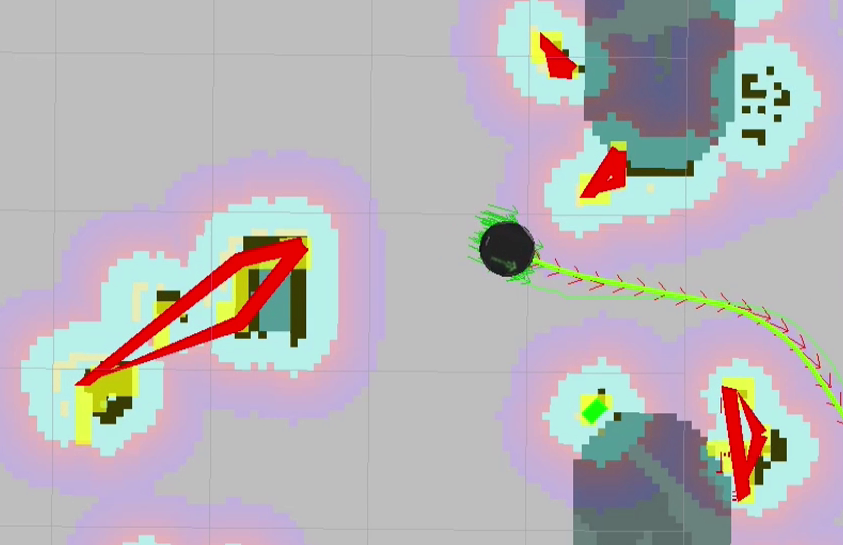
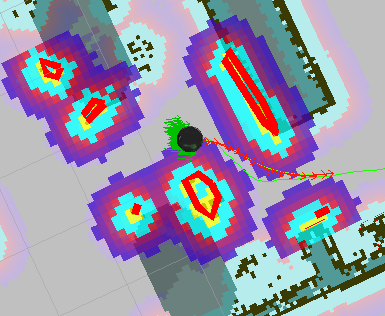
Parameters
~<name>/cluster_max_distance (double, default: 0.4)
- Parameter for DB_Scan, maximum distance to neighbors [m]
- Parameter for DB_Scan: minimum number of points that define a cluster
- Parameter for DB_Scan: maximum number of points that define a cluster (limit cluster size to avoid large L- and U-shapes)
- Clear keypoints/vertices of the convex polygon that are close to each other [distance in meters] (0: keep all)
CostmapToPolygonsDBSConcaveHull
This plugin converts occupied cells to a set of non-convex (concave) polygons. The conversion is performed in three stages:
- Generate clusters using DBSCAN.
- Convert clusters to convex polygons.
- Convert convex polygons to concave polygons
Reference: J.-S. Park et al. A New Concave Hull Algorithm and Concaveness Measure for n-dimensional Datasets. Journal of Information Science & Engineering 28 (2012) 3.
Examples are depicted in the following figures. Only yellow cells are occupied cost cells (without inflation)! Additionally, just the local map has been converted and not the complete static map.
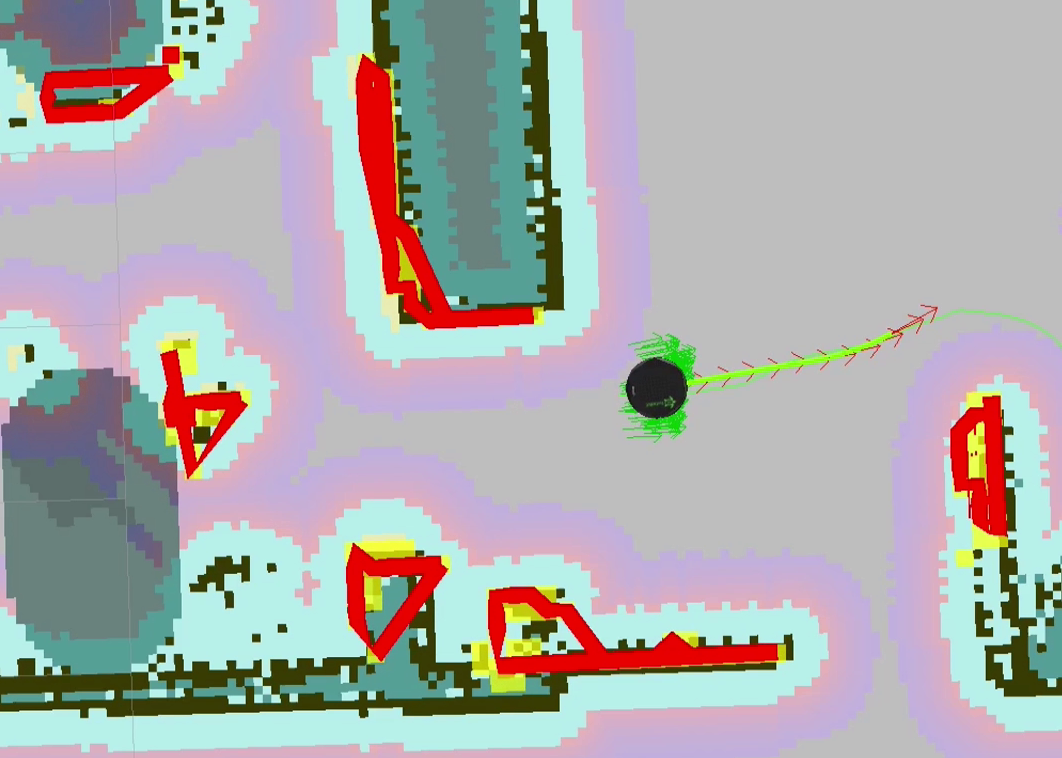
Parameters
~<name>/cluster_max_distance (double, default: 0.4)
- Parameter for DB_Scan, maximum distance to neighbors [m]
- Parameter for DB_Scan: minimum number of points that define a cluster
- Parameter for DB_Scan: maximum number of points that define a cluster (limit cluster size to avoid large L- and U-shapes)
- Clear keypoints/vertices of the convex polygon that are close to each other [distance in meters] (0: keep all)
- Smaller depth: sharper surface, large depth: convex hull
CostmapToLinesDBSMCCH
This plugin converts occupied cells to a set of lines (and points). This plugin converts occupied cells to a set of non-convex (concave) polygons. The conversion is performed in three stages:
- Generate clusters using DBSCAN.
- Convert clusters to convex polygons.
- Convert polygon edges to lines if there exist at least a predefined number of support points.
Examples are depicted in the following figures. Only yellow cells are occupied cost cells (without inflation)! Additionally, just the local map has been converted and not the complete static map. Converted points and polygons are colored in red while lines are colored in green.
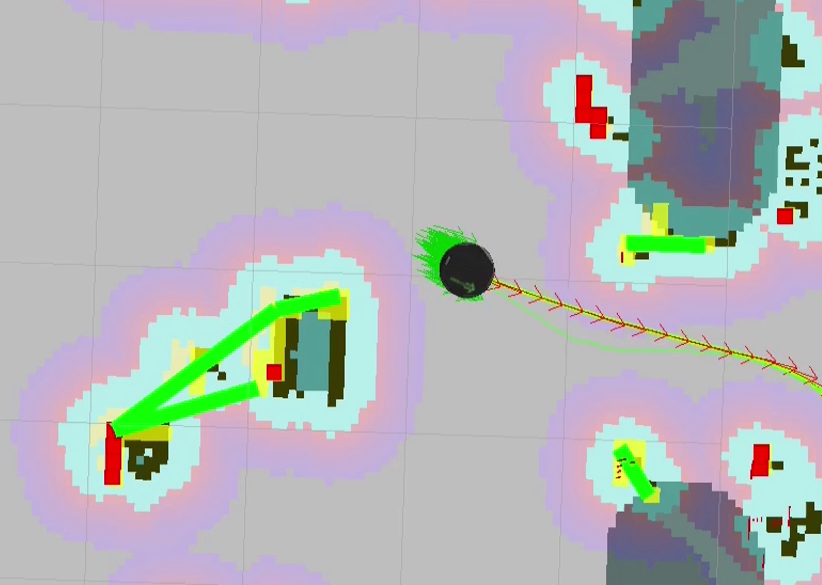
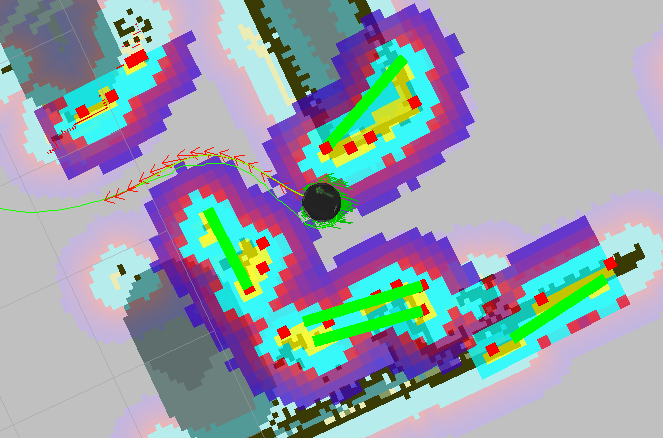
Parameters
~<name>/cluster_max_distance (double, default: 0.4)
- Parameter for DB_Scan, maximum distance to neighbors [m]
- Parameter for DB_Scan: minimum number of points that define a cluster
- Parameter for DB_Scan: maximum number of points that define a cluster (limit cluster size to avoid large L- and U-shapes)
- Clear keypoints/vertices of the convex polygon that are close to each other [distance in meters] (0: keep all)
- Minimum distance from a point to the line to be counted as support point
- A line is only defined, if the distance between two consecutive support points is less than this treshold. Set to 0 in order to deactivate this check.
- Minimum number of support points required to represent a line.
CostmapToLinesDBSRANSAC
This plugin converts occupied cells to a set of lines (and points). The conversion is performed in two stages:
- Generate clusters using DBSCAN.
RANSAC algorithm is used to find straight line segment models (https://en.wikipedia.org/wiki/RANSAC) RANSAC is invoked repeatedly to find multiple lines per cluster until the number of inliers is below a specific threshold. Outliers are also treated as polygons (represented as a single vertex each). Resulting lines of RANSAC are currently not refined by linear regression.
Examples are depicted in the following figures. Only yellow cells are occupied cost cells (without inflation)! Additionally, just the local map has been converted and not the complete static map. Converted points and polygons are colored in red while lines are colored in green.
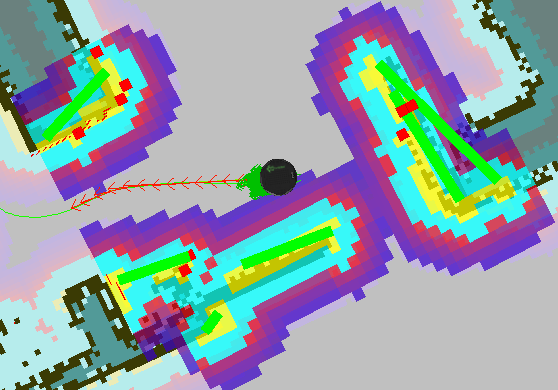
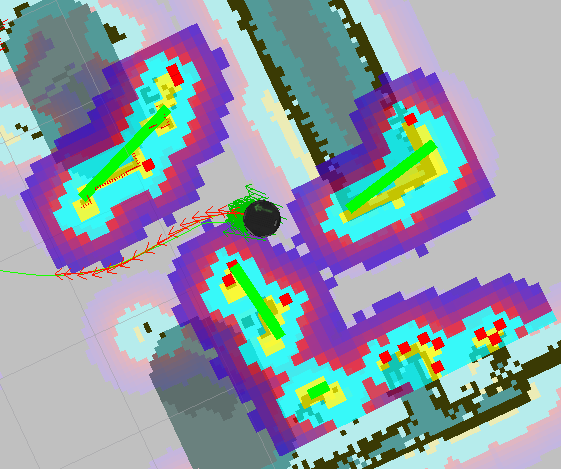
Parameters
~<name>/cluster_max_distance (double, default: 0.4)
- Parameter for DB_Scan, maximum distance to neighbors [m]
- Parameter for DB_Scan: minimum number of points that define a cluster
- Parameter for DB_Scan: maximum number of points that define a cluster (limit cluster size to avoid large L- and U-shapes)
- Maximum distance to the line segment for inliers [in meters].
- Minimum numer of inliers required to form a line.
- Number of ransac iterations per cluster.
- Abort ransac iterations if the number of outliers is equal or below the value specified here.
- Convert remaining outliers to single points.
- Filter the interior of remaining outliers and keep only keypoints of their convex hull.
- Clear keypoints/vertices of the convex polygon that are close to each other [distance in meters] (0: keep all)
Standalone Node
The costmap_converter interface is intended to be directly included in the source code. However, sometimes it could be useful to convert an incoming nav_msgs/OccupancyGrid Message (e.g. as published by navigation).
For that purpose the internal standalone_converter node (costmap_converter_node.cpp) might be employed. Currently, parameters are hardcoded. These are going to be substituted with changeble parameters in an upcoming release. Before then please inspect the source code for further details.







